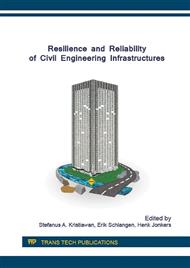p.240
p.246
p.252
p.259
p.265
p.274
p.283
p.293
p.299
Structural Performance Evaluation with Pushover Analysis Case Study: The Integrated Central Surgery Building, Bethesda Hospital in Yogyakarta
Abstract:
The Earthquake causes damage to buildings and casualties. Design of buildings against earthquake loads is very important so during an earthquake the building does not collapse and no casualties. Especially for important buildings like the Ingrated Central Surgery Building or Gedung Bedah Sentral Terpadu (GBST) Bethesda Hospital Yogyakarta is expected to keep functioning and have not experienced significant damage after the earthquake. In performance based design, level of performance for hospital buildings is lmmediate Occupancy (IO). The purpose of this research is to know actually performance level of the structure GBST Bethesda Hospital in Yogyakarta. Evaluation method use is non-linear static analysis (Pushover). The lateral load determining by static equivalent analisys, the lateral load given monotonic in one direction step by step. Performance level determine in Capacity Spectrume Method according Applied Technologi Council (ATC 40,1996) the result is performance point and displacement targets method according Federal Emergency Management Agency (FEMA 356,2000). Structure performance level specified by drift ratio required by ATC 40 (1996). The result of evaluation according ATC 40 (1996) in the X direction obtained value of displacement at 0.174m, in the direction Y at 0.185m while the according FEMA 356 (2000) the displacement in direction X at 0.137m and Y direction at 0.179m. The value of drift ratio actual is less than 1% so the performance level for earthquake return period of 2500 years is the Immediate Occupancy.
Info:
Periodical:
Pages:
265-273
Citation:
Online since:
July 2016
Authors:
Price:
Сopyright:
© 2016 Trans Tech Publications Ltd. All Rights Reserved
Share:
Citation:


